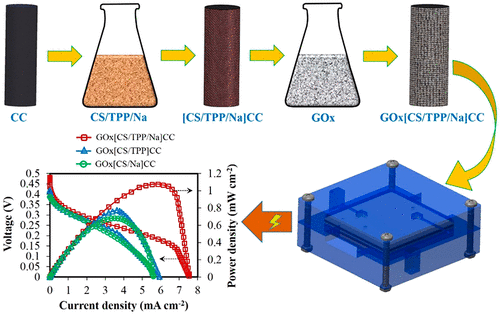当前位置:
X-MOL 学术
›
Energy Fuels
›
论文详情
Our official English website, www.x-mol.net, welcomes your feedback! (Note: you will need to create a separate account there.)
Improving the Immobilization of Glucose Oxidase on Carbon Cloth Via a Hybrid Approach of Cross-Linked Chitosan/TPP Matrices with Na Polymers for High-Performance Self-Pumping Enzyme-Based Biofuel Cells
Energy & Fuels ( IF 5.3 ) Pub Date : 2020-07-02 , DOI: 10.1021/acs.energyfuels.0c01033 Ngoc Bich Duong, Van Men Truong, Yi-Shiuan Li, Chih-Liang Wang, Hsiharng Yang
Energy & Fuels ( IF 5.3 ) Pub Date : 2020-07-02 , DOI: 10.1021/acs.energyfuels.0c01033 Ngoc Bich Duong, Van Men Truong, Yi-Shiuan Li, Chih-Liang Wang, Hsiharng Yang

|
The real-world application of an enzyme-based biofuel cell (EBFC) requires the desirable immobilization of enzymes on the electrode surface, offering the feasibility of addressing its short lifetime and low-power density. Nevertheless, an efficient immobilization of enzymes strongly relies on the preferred scaffolding between the enzyme and the electrode. Accordingly, the development of a promising route to attain a tunable scaffold structure is urgently required. Herein, we present a facile and ecofriendly route for efficiently controlling the scaffold structure by investigating the interplay of tripolyphosphate (TPP), chitosan (CS), and Na. A series of glucose oxidase (GOx)-based anodic electrodes, GOx[CS/TPP]CC, GOx[CS/Na]CC, and GOx[CS/TPP/Na]CC, are synthesized using CS/TPP, CS/Na, and CS/TPP/Na as the scaffolding on carbon cloth (CC) followed by the immobilization of GOx for a comparative study of the microstructure, enzyme loading, and electrochemical property. It is revealed that the self-pumping EBFC, driven by capillary force, utilizing GOx[CS/TPP/Na]CC can deliver a higher peak power density (1.077 mW cm–2) than that utilizing GOx[CS/TPP]CC (0.776 mW cm–2) and GOx[CS/Na]CC (0.682 mW cm–2). The self-pumping EBFC utilizing GOx[CS/TPP/Na]CC can retain 89.2% of its beginning performance even after 240 h of testing, as compared with that utilizing GOx[CS/Na]CC (61.1%). This enhancement can be attributed to the formation of a desirable scaffold structure via the cross-linked CS/TPP matrices combined with Na polymers for the hybrid enzyme immobilization, simultaneously offering the capability of improving the enzyme-loading efficiency, facilitating the interaction between the surface electrode and the enzyme, and preventing the release of the enzyme during the cell operation.
中文翻译:

通过交联的壳聚糖/ TPP基质与Na聚合物的混合方法提高高性能自泵送酶基生物燃料电池的葡萄糖氧化酶在碳布上的固定化
酶基生物燃料电池(EBFC)的实际应用需要将酶理想地固定在电极表面上,从而提供解决其寿命短和低功率密度的可行性。然而,酶的有效固定强烈依赖于酶和电极之间的优选支架。因此,迫切需要开发有希望的途径来获得可调节的支架结构。在本文中,我们通过研究三聚磷酸(TPP),壳聚糖(CS)和Na的相互作用,提出了一种有效控制脚手架结构的简便且生态友好的途径。使用CS / TPP,CS / Na合成一系列基于葡萄糖氧化酶(GOx)的阳极电极GOx [CS / TPP] CC,GOx [CS / Na] CC和GOx [CS / TPP / Na] CC ,CS / TPP / Na作为碳布(CC)的支架,然后固定GOx,以比较研究其微观结构,酶负载和电化学性能。结果表明,在毛细管力的作用下,利用GOx [CS / TPP / Na] CC进行的自泵浦EBFC可以提供更高的峰值功率密度(1.077 mW cm–2),而不是使用GOx [CS / TPP] CC(0.776 mW cm -2)和GOx [CS / Na] CC(0.682 mW cm -2)。与使用GOx [CS / NaCC](61.1%)相比,使用GOx [CS / TPP / Na] CC自泵的EBFC甚至在240小时的测试后仍可以保持其89.2%的初始性能。这种增强可以归因于通过交联的CS / TPP基质与Na聚合物结合形成理想的支架结构,以固定杂化酶,同时提供了提高酶负载效率,促进表面之间相互作用的能力。电极和酶,并防止细胞操作过程中酶的释放。
更新日期:2020-08-20
中文翻译:

通过交联的壳聚糖/ TPP基质与Na聚合物的混合方法提高高性能自泵送酶基生物燃料电池的葡萄糖氧化酶在碳布上的固定化
酶基生物燃料电池(EBFC)的实际应用需要将酶理想地固定在电极表面上,从而提供解决其寿命短和低功率密度的可行性。然而,酶的有效固定强烈依赖于酶和电极之间的优选支架。因此,迫切需要开发有希望的途径来获得可调节的支架结构。在本文中,我们通过研究三聚磷酸(TPP),壳聚糖(CS)和Na的相互作用,提出了一种有效控制脚手架结构的简便且生态友好的途径。使用CS / TPP,CS / Na合成一系列基于葡萄糖氧化酶(GOx)的阳极电极GOx [CS / TPP] CC,GOx [CS / Na] CC和GOx [CS / TPP / Na] CC ,CS / TPP / Na作为碳布(CC)的支架,然后固定GOx,以比较研究其微观结构,酶负载和电化学性能。结果表明,在毛细管力的作用下,利用GOx [CS / TPP / Na] CC进行的自泵浦EBFC可以提供更高的峰值功率密度(1.077 mW cm–2),而不是使用GOx [CS / TPP] CC(0.776 mW cm -2)和GOx [CS / Na] CC(0.682 mW cm -2)。与使用GOx [CS / NaCC](61.1%)相比,使用GOx [CS / TPP / Na] CC自泵的EBFC甚至在240小时的测试后仍可以保持其89.2%的初始性能。这种增强可以归因于通过交联的CS / TPP基质与Na聚合物结合形成理想的支架结构,以固定杂化酶,同时提供了提高酶负载效率,促进表面之间相互作用的能力。电极和酶,并防止细胞操作过程中酶的释放。



























 京公网安备 11010802027423号
京公网安备 11010802027423号